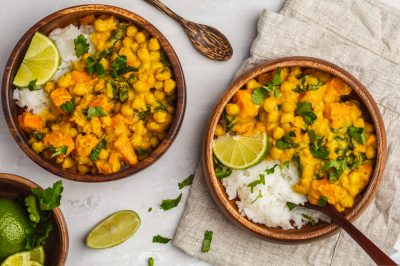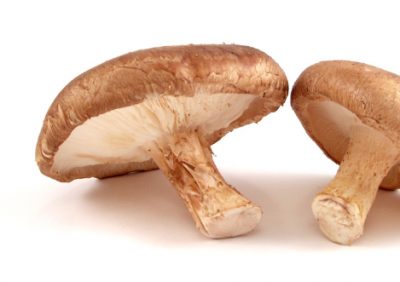Thai Pumpkin & Sweet Potato Chickpea Coconut Curry

I love the saying Hara Hachi Bu: Stop Eating When You’re 80% Full. The Okinawan elders have used this phrase for centuries before beginning their meal. It's a perfect reminder to stop eating when our stomachs are 80 percent full. We ask all our students who come to study with us to build this awareness into their daily lives when eating breakfast, lunch and dinner.
Many of us eat way too fast, hardly chewing our food at all. It's almost like, bite, swallow, done! when watching some people eat. This causes not only digestive issues but also weight gain as you eat way too many calories. A good idea is to use chopsticks, it makes you take smaller mouthfuls. Another idea is to put your utensils down in between each mouthful of food and really chew. It's also good to remind ourselves that the people of Okinawa, have the longest living people on the planet and the largest population of centenarians.
Here is a tasty dish to allow you to try this way of eating slower whilst savouring each delicious mouthful. This is a lovely curry that sings with all the splendour of comfort. The curry sauce is thickened with coconut cream which adds that touch of richness. Try it and see just how truly wonderful eating slowly and really tasting the food can be.
For the Curry Sauce:
1 ½ cups coconut cream
3 garlic cloves,
1 x inch piece ginger, peeled and chopped
2 tsp. ground coriander
1 tsp. ground cumin
1 tsp. mild curry powder
1 tsp turmeric
Juice from two limes
2 tbsp. tamari
1 tbsp umeboshi paste
For the Broth
1 sachet umami instant stock dissolved ¼ cup warm water
3 kaffir lime leaves (whole)
2 cups pumpkin or squash, peeled and chopped into bite size pieces
4 cups sweet potato chopped into bite size pieces
1 ½ cups cooked chickpeas
½ cup coconut cream
1 large bunch of kale, leaves only, chopped and steamed
Serving
Small handful coriander or basil leaves, fresh for garnish
Lime slices
Place all curry sauce ingredients together in a blender. Blend well to create a fragrant yellow sauce. Pour the curry sauce into a heavy based wok. Add the dissolved umami instant stock, plus the lime leaves, stirring to incorporate. Stir in the pumpkin and sweet potato. Bring to a boil then reduce heat to a low simmer. Stir in the chickpeas, cover and allow to simmer 20 minutes, or until the vegetables are soft enough to poke through with a fork. Meanwhile, steam the kale for 4-5 minutes until vibrant green.
Add the remaining half cup of coconut cream and taste, adjusting flavours to suit your palette. Add a little chili if you desire a spicy curry. Stir in the steamed kale and add a little more liquid if you desire a more 'soupy' texture. Transfer the curry into a serving dish, or into individual bowls. Top with a sprinkling of fresh coriander or basil. Serve with white basmati, Thai jasmine rice or millet and some lime slices.
You will find over 80 delicious recipes in my latest book Go Vegan. My book is jam packed with nutritional information, ancient wisdom coupled with nutritional science and the foreword written by T. Colin Campbell Center for Nutrition Studies.
In good health
Immune Boosting Shiitake Mushrooms

Biologists consider shiitake and other mushrooms to be fungi, a group of primitive plants. Since they have no green pigments (chlorophyll), they cannot make food from sunlight as other plants, but must live by eating plants. Shiitake’s favourite food is dead hardwood trees. The word “shii” is derived from the shii tree (Quercus cuspidate), an oak of central and southern Japan upon which shitake most often grow. “Take” means mushroom in Japanese (it is repetitious to say “shiitake mushroom”).
Ancient Foods For Modern Cooks
The part of shiitake that we eat, the fleshy cap, is actually a primitive reproductive structure of the plant that produces billions of microscopic spores. When two compatible spores get together, they fuse their cytoplasm and genetic material and, if food is available, grow into a new mushroom. When two compatible spores combine, they form the mycelium. In the case of shiitake, mycelium grows inside the log, using its powerful enzymes to transform wood into food. After a period of time, environmental stresses such as food depletion or temperature and humidity changes cause the mycelium to form a reproductive structure-the mushroom-and the cycle is complete.
In early autumn, as trees shed their leaves in preparation for a dormant winter, the carbohydrate level in the tree trunk rises, making an ideal food for shiitake growth.
Beginning in the 1960’s, scientists launched an extensive search to uncover the secret of shiitakes legendary healing powers. Their studies-about one hundred in all-focused on shiitake’s ability to rapidly lower serum cholesterol, as well as this mushroom’s potent antitumour, antiviral and antibiotic properties.
Shiitakes and Immunity
Many of the human diseases currently increasing throughout the world have no specific cures. Immune-system failure or dysfunction is a common element in cancer, viruses and immune-deficiency diseases. Many scientists around the world contend that there is increasing evidence that the health-promoting compounds found in medicinal and edible fungi, including shiitake, stimulate the immune system. The temperatures of cooking do not seem to destroy shiitakes healing qualities, in addition, cooking greatly enhances the mushrooms flavour. You can cook fresh shiitake in all the ways you are used to enjoying other mushrooms in soups, stews, sauces and gravies. The dried shiitake mushrooms I use in many of my recipes from my latest book Go Vegan not only taste amazing but they will build your immunity.
In good health


